Everything is at home: Turkey is committed to an independent military industry
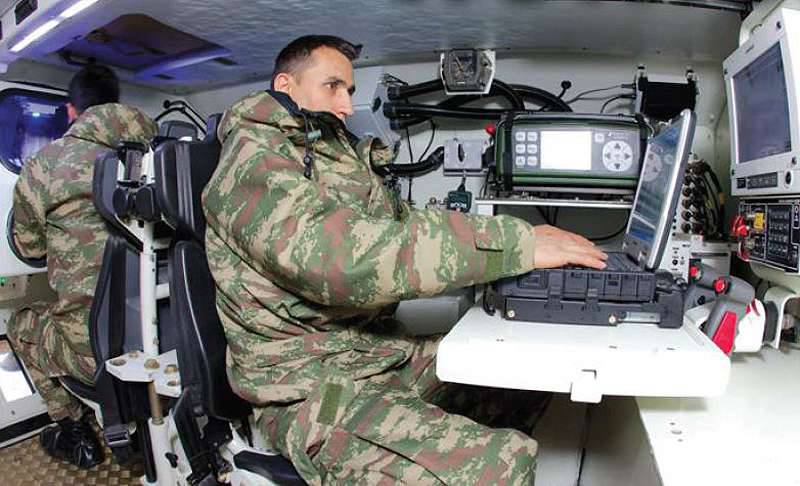
Inside the car Pars 6x6 RCB Intelligence
Turkey’s ambitious plans to reduce dependence on foreign suppliers and create an independent defense industry seem to be implemented.
The intention of a number of countries to modernize their armed forces, create local industrial facilities and get new and modernized weapons requires a fair amount of effort.
The costs of creating an entire industry, gaining experience in designing and manufacturing, and further accumulating military knowledge about how to properly use new weapons and technologies are prohibitively high and, moreover, this process can take several decades.
The leadership of many countries seeks to reduce their dependence on Western or Russian weapons and spend as much money on defense as possible inside the country, but often the success is quite average, despite the huge amounts of money wasted. However, there are several successful examples - China, the United Arab Emirates and Brazil, which are successful for various reasons.
But Turkey stands out among such countries. Since the middle of the 80s, it has tirelessly attracted advanced technologies to the country and, as a result, by the year 2011 achieved that 54% of military products were produced domestically. But the main thing is that Ankara wants to spend money on weapons procurement programs that will ensure the development of technology, support the business and not allow it to wither. In accordance with current plans, defense expenditures up to 2023 will amount to 70 billions of dollars.
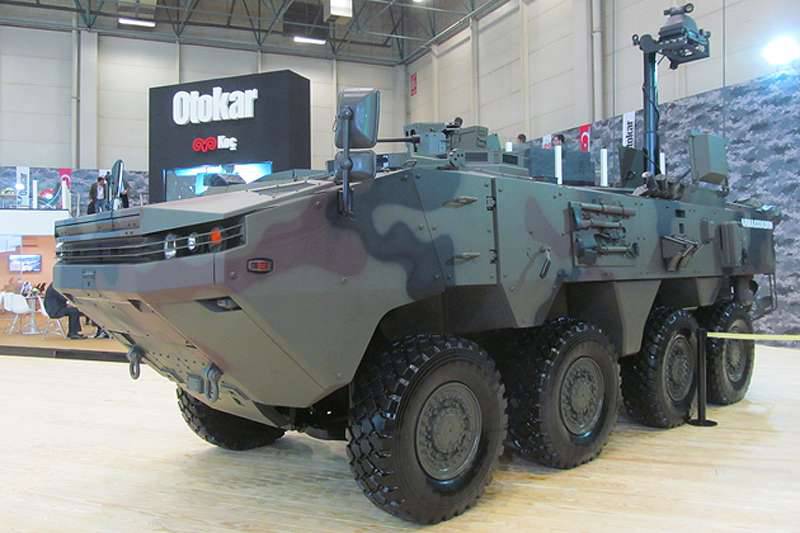
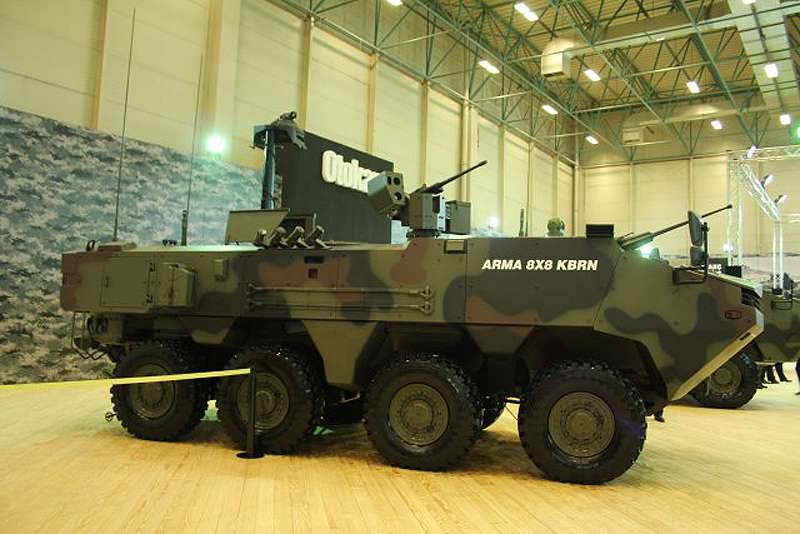
A new version of the Arma 8x8 intelligence RCB is participating in the competition for the Turkish Special Purpose Vehicle
Ground sector
In the ground sector, the main efforts are focused on vehicles, here the Turkish army is implementing ambitious projects in order to become self-sufficient in the field of armored mobility. It concerns development tanks, infantry fighting vehicles, BTR families and specialized vehicles where there is healthy competition between the two main local manufacturers: FNSS and Otokar.
The most difficult task is to develop a new main battle tank (MBT), but the country coped with this task. Otokar developed the final prototype of the Altay tank, the qualification tests of which are at the final stage. A fully functional prototype, known as PV2, was shown at the latest IDEF in Istanbul; This is one of two (the second is PV1 designation) machines manufactured at the end of 2014 of the year.
Earlier, the first two prototypes were made, but they were used for preliminary running and fire tests at the Şereflikoсhisar test site. Otokar's tank systems manager Oguz Kibaroglu (Oguz Kibaroglu) said that under the program of the Turkish army and the Defense Procurement Directorate (SSM) PV1, the running and life tests will pass, and the PV2 prototype will pass fire testing.
Turkish MBT Altay at IDEF
SSM selected Otokar as the contractor for the development of the Altay tank in March 2007, and in July 2008 issued a contract worth 500 million dollars for Phase I design, development, testing and qualification. According to SSM management, Phase I, which began in January 2009 of the year and lasted for 18 months, consisted of three stages in which analysis and preliminary design were performed.
He added that at Stage II, which ended in late November, detailed design and manufacture of the first two experimental mobile stands for running and fire tests was carried out. The development of these two machines ended with the production of prototypes PV1 and PV2.
The program is currently in Phase III. A company spokesman said that after the construction, the two vehicles “are currently undergoing comprehensive qualification tests with the participation of the Turkish army. In accordance with the mass production contract, the first batch of mass-produced vehicles will consist of 250 tanks, and production is expected to begin in the 2018 year. ”
Replacing OBT
At the beginning, the Altay MBT will replace the current M48 and M60 tanks that have not been upgraded, then the upgraded M60 tanks will be replaced and, eventually, it will replace the Leopard A4 tanks purchased from Germany.
The main weapon is the 120-mm smooth-bore hand-loading gun L55 produced by the local company MKEK, Aselsan will supply the fire control system (FCS) and the battle control system, and Roketsan will supply the reservation kit.
The Aselsan MSA, which includes laser rangefinders and day / night sights of the gunner-gunner and the commander, offers shock search capabilities and provides a high probability of hitting the first shot.
The tank is equipped with a warning system for laser irradiation, a battle management system, a friend-to-friend recognition system and an all-view 360 ° system, which includes the driver’s front and rear camera. Also installed on the tank 16 smoke grenade launchers.
The Altay tank is equipped with a Euro V12 power unit with an 1500 horsepower, a transmission with five forward and three reverse gears, as well as a cooling system. This power unit allows you to reach speeds of up to 65 km / h.
The crew consists of four people, and a remote-controlled combat module (SDM) on the turret roof can receive either an 7,62-mm or 12,7-mm machine gun. A laser rangefinder and day / night sights are also installed in the DUBM.
The survivability components include a passive booking package on the hull and tower, additional composite armor and dynamic protection units to protect against cumulative and armor-piercing threats. There is also a mine protection, life support system, auxiliary power unit and a laser radiation warning system.
Fighting vehicles
Another major program for the development of ground-based machines received the designation WCV (Weapon Carrying Vehicle - weapon transporter). It is also known as the Tactical Wheeled Armored Weapon Carrier project (Tactical Wheeled Armored Armament Platform) or the Anti-Tank program.
According to SSM, there is a need for 184 tracked and 76 wheeled vehicles, that is, a total of 260 platforms. This is significantly less than originally intended for the original TWAWC project, which provided for the purchase of 1075 machines.
Two applicants for this program are the companies FNSS and Otokar and both submitted their projects for consideration. In its role as a tank destroyer, the machine must carry anti-tank guided missiles (ATGM) on board and reportedly the SSM Directorate has already chosen the Russian Cornet-E complex and the Turkish Mizrak-O from Roketsan for installation on the machine, although the management does not confirm this. The Mizrak-O is a medium-range anti-tank guided missile with an infrared homing head with a tandem warhead and a range of 4 km.
At IDEF 2015, Otokar showed a new version of the tracked armored vehicle from its Tulpar family, called the Tulpar-S. It was installed on the new OBSA company Aselsan, armed with four anti-tank Cornet and machine gun.
New Otokar Tulpar-S Platform
Tulpar-S has a width of 2,9 meters, a length of 5,7 meters and a reservation level corresponding to STANAG Level 4. The machine, available in various versions, including infantry fighting vehicles and armored personnel carriers, can take a variety of weapons systems. The machine is equipped with an 375 horsepower engine. allowing you to reach speeds of up to 70 km / h. Also installed a system of protection against weapons of mass destruction, energy absorbing seats, as well as thermal and video cameras for the driver.
Pars 4x4 at IDEF 2015. FNSS offers this platform as a base for the Weapon Carrying Vehicle program.
Wheels and tracks
FNSS has submitted its application for two systems: the wheeled anti-tank missile system (ATGW) and the tracked ATGM. The company says it is developing tactical and technical specifications and feasibility studies for both options. Both platforms are developed from scratch, both tracked and wheeled 4x4.
The wheeled challenger is an experimental version in the 4x4 configuration from the Pars 6x6 and 8x8 family; It was first shown at IDEF in 2015. In the Turkish armed forces, a floating armored car will serve in several versions: an anti-tank installation, operational control and reconnaissance.
At this show, a representative from FNSS said that operational tests will take place in 2016. The presented vehicle, which can accommodate a 5 man, was in a version of operational control with an Aselsan SARP company installed with an 12,7-mm machine gun.
The Pars 4x4 armored car has a length of about 5 meters, a width of 2,5 meters and a height of 1,9 meters on the roof of the hull. It has thermal imaging and daytime cameras with a wide field of view, which significantly increase the level of control of the situation in the daytime and at night.
The machine is also available in the ATGM variant, which will meet the requirements of the WCV project, providing for the installation of an anti-aircraft engine and anti-tank guided missile system. As a tactical vehicle, it can be equipped with a manned turret with an 7,62-mm, 12,7-mm machine gun or an 40-mm automatic grenade launcher.
Four-wheel drive 4x4 can switch to 4x2 mode for driving on roads where the car can reach speeds up to 120 km / h; without training, she overcomes water obstacles, developing 8 km / h speed on the water with the help of two propellers.
The representative of the company also added that most of the subsystems can be changed depending on the requirements.
The detailed characteristics of the WCV project were published in 2014 and in December of the same year, the companies Otokar and FNSS submitted their responses to the request for information. The WCV project was to be approved at the end of 2015 of the year, but according to unconfirmed data, the execution of the program for the new wheeled vehicle was entrusted to FNSS, which is currently discussing the terms of the contract. It is worth noting that the applications for the tracked version from FNSS and for the wheeled version from Otokar were not published within the framework of the WCV project.
Special tasks
In addition to the WCV program in Turkey, another major project is being implemented to develop a specialized SPV (Special Purpose Vehicle) vehicle. The SSM Office confirmed that there is still a need for 428 tactical wheeled vehicles, which can be divided into 121 command vehicles, 217 surveillance vehicles, 30 radars and 60 RCB intelligence vehicles.
However, at the beginning of 2015, it was a question of 472 machines, since it was then supposed to purchase not 30, but 74 mobile radar. Sanitary option was also in the previous plans, but, most likely, he was not destined to appear in this world.
The SSM spokesman, when asked about any progress on this program, said that “while the evaluation process is in progress”. Machines shipped to meet the above needs are expected to be in the 6x6 and 8x8 variants and here FNSS and Otokar will cross their swords with their offers for the second time.
You may notice that the 60 intelligence vehicles of the WMD out of the total number of 428 units may seem too high, but this seems to be related to the chemical attack carried out in the suburbs of Damascus in the 2013 year (many things are not clear here, the parties blame each other). The requirement for the SPV project appeared as early as the 2010-2011 years, but really began to materialize only in the second half of the 2014 year. The decision on the program is expected no earlier than the end of 2016 of the year, and maybe even later.
Rhb intelligence machine
FNSS has developed a new version of the RCB intelligence of its Pars 6x6 armored vehicle specifically for such tasks. It was first shown at the IDEX exhibition, held in Abu Dhabi at the beginning of 2016. The company then stated that it was the first WMD intelligence vehicle (weapons of mass destruction) developed and manufactured in Turkey, and that 60 vehicles would be produced as part of the SPV program.
Pars 6x6 machine in the version of RCB-intelligence
Development is still ongoing, before a full-scale production contract is issued, a number of pre-production contracts for the manufacture and development of a larger number of experimental machines are expected. Let us dwell on this machine.
The reconnaissance and reconnaissance reconnaissance or reconnaissance reconnaissance vehicle has capabilities for detecting and identifying poisonous warfare agents and toxic industrial substances (including the possibility of remote detection), determining radiation and detecting and identifying biological substances.
The system of collective protection against weapons of mass destruction, installed in the machine PARS 6x6, creates an overpressure inside, and also has respirators with forced air supply. The collective defense system complies with the NATO standard AEP-54.
The machine is also equipped with a stabilized remote-controlled combat module, in which, according to customer requirements, an 40-mm automatic grenade launcher, 12,7-mm or 7,62-mm machine gun can be installed.
The vehicle houses a reconnaissance group of four people, including the driver, the commander of the vehicle / group, and two chemical operators. An additional seat was installed in the PARS 6x6 machine in order to increase the operational capabilities and crew efficiency, in particular, in the selection and processing of biological and chemical samples for further analysis. The FNSS reconnaissance machine from the company FNSS can also be based on the PARS 8х8 machine, in which you can, if necessary, place an enlarged group and more equipment.
Chemical detection and identification: PARS 6x6 is equipped with three chemical reconnaissance units to continuously monitor the presence of chemical and toxic materials outside and inside the machine. An additional device has also been installed, which is used to further identify solid and liquid samples in the glove box of the machine. If necessary, this device can also be removed from the machine to perform dismounted operations.
The machine is equipped with a remote detection device, it uses laser technology and can determine the composition of substances at a distance of 5 km. Also, a gas chromatograph and a mass spectrometer are installed in the PARS 6x6 machine for additional detailed chemical analysis of a set of samples. If necessary, these devices are available for dismounted operations.
Biological Detection and Identification: An OMP PARS 6x6 intelligence machine can conduct continuous intelligence on biological substances. When a potential biological substance is detected, an auxiliary sample is taken for additional analysis, and sampling and analysis are performed inside the integrated glove box, which is designed to ensure the safety of the operator. Thanks to the integrated design of the glovebox, several soil samples can be placed into it at once through a sampling device for further analysis and identification.
Radiological and nuclear detection: in order to warn the crew of the direction and level of any radiation hazard, gamma-radiation detectors are installed inside the vehicle. The PARS 6x6 is also equipped with an internal radiation detector and crew crew dosimeters to protect personnel and monitor dose rate.
Manual sampling and marking of the infection area: PARS 6x6 has onboard a sampling system that continuously detects the movement and provides additional sample analyzes. Soil samples can be taken safely by the operator from inside the machine and stored outside the machine until further transport and laboratory analysis.
The integrated zone marking system in the PARS 6x6 reconnaissance vehicle allows the operator to mark any identified contaminated area without leaving the vehicle. NATO standard marking flags are installed from the machine using a blocking delivery system that constantly maintains excess pressure and crew safety.
Central Processing Unit and Specialized Software: The WMD detection devices integrated into the PARS 6x6 machine work on the WMD warning program, which provides the crew with timely warning signals and information about any potential threat of the WMD. Information is collected, processed together with data received from a meteorological sensor and a GPS station, and transmitted through the on-board communication system in ATP 45 format.
Otokar Response
In response to the machinations of its rival, a couple of months later, at IDEF 2015, Otokar showed its own intelligence vehicle, OMP Arma CBRN.
A spokesman for Otokar said that a modified version of the Arma 8x8 was designed to meet the requirements of the Turkish army, in which this machine is described as “floating, having a set of sensors for conducting chemical and radiation reconnaissance, capable of performing remote detection and automatic sampling.”
The company said that its version of the SPV CBRN is also the first vehicle of a similar purpose developed by the local industry (after gaining experience in producing the Cobra 4x4 version for Slovenia in 2008, the company in 2011 created its reconnaissance vehicle Arma 6x6).
The prototype in the wheel configuration 8x8 has a crew of six people, it has a remote detection system with an infrared detector on a retractable manipulator arm with a long reach. In the stern of the machine, a sampling wheel and a filtration system are installed.
A Keskin SDS was installed on the roof of the presented sample for self-defense, a meteorological sensor was installed on the roof, which not only measures wind speed, but can predict the spread of contamination at various time intervals. There is also a manual labeling system in the stern, with which you can arrange various indicators, such as flags, to indicate routes and warnings of other units.
The company Otokar reported on the development of its own software RCB-intelligence, which will be integrated with various sensors and sensors. Communication equipment in the car complies with ATP 45 standards, respectively, this allows you to exchange information with other NATO platforms.
Turkey has a need for various radiation detectors (alpha, beta, gamma, neutron), and these capabilities are provided by different sets of equipment, since there is no single detector yet.
Unfortunately, the required functionality is not disclosed, so it is not clear how the Turkish army wants to use these machines (for example, the number of units equipped with HAPSITE chemical analysis systems), and, therefore, it is impossible to determine the composition of sets of equipment.
HAPSITE Chemical Analysis Device
The contract winner company will provide a training package for the supplied set of equipment, but again, how the army will use these machines is not yet determined.
Since there are several ways to carry out RCB intelligence, it is quite possible that the army will acquire both vehicles and, over time, will determine its preferred standard methods of work within the framework of developing the concept of combat use.
Equally
And finally, another program in which companies FNSS and Otokar are fighting directly with each other. This is a floating amphibious assault vehicle (AAV). The SSM Office reported that the request for proposals was published in March of the 2014 of the year and today there is a need for an 23 BTR, two operational control machines and two evacuation vehicles.
The company FNSS declares that it has extensive experience in this field and therefore is able to design and manufacture vehicles that can safely deliver the Turkish marines from the landing ships docks to the coast and to enemy facilities on the coast.
The company says that "the submitted application for the competition, which is expected to be completed by July 2016, is based on the original platform."
As for the other programs, Turkey has purchased 617 Kirpi mini-protected machines from a local company BMC since 2013, when this project was reanimated. In addition, the company received a contract in October 2014 of the year for 60 machines for the delivery of special units of the Turkish Office of Internal Security. At IDEF 2015, BMC showed its multi-purpose vehicle Vuran 4x4 for this program. Production of these machines is in full swing, deliveries began in the middle of 2015 year.
The Vuran armored vehicle has a six-liter Cummins turbo diesel engine that can run on F34 fuel. The machine has a V-shaped hull, loopholes for firing on the sides, a ventilation system and an emergency hatch. Carrier cabin with energy absorbing seats and anti-mine / ballistic protection. Transmission automatic with six forward gears and one rear with adjustable high and low revs.
Vuran 4x4 at IDEF 2015
In order to increase all-terrain on all types of terrain, Vuran also has an independent suspension with coil springs and telescopic shock absorbers, anti-lock brakes, power steering and 395 / 85 R20 wheels.
The Vuran machine is equipped with a system of centralized pressure control in tires, fire resistant inserts in the wheels and machine gun installation in the cab. It is equipped with a GPS system, rear-view camera, automatic fire extinguishing system and lighting equipment with blackout. The machine can overcome the 30 ° slide, water barriers to a depth of 80 cm, power reserve is 600 km.
The original Tulpar car (pictured with the tower) was created as a base for a family of armored vehicles for various purposes.
Multipurpose platform
Otokar's original Tulpar machine, first shown at IDEF 2013, is a multipurpose platform weighing from 25 to 45 tons, which can have many options: BTR, BMP, sanitary, 105-mm anti-tank installation, mortar transporter, maintenance, evacuation, engineering , reactive volley fire system, anti-aircraft and reconnaissance.
The upgraded version of 32 ton mass, presented at IDEF 2015, had a 7,23 meter length, a 3,45 meter width, and a medium caliber MIZrak-30 submachine gun with 30-mm automatic cannon with selective power and 210 ammunition shells installed on it.
The operational tests of the Tulpar machine have been completed and Otokar is currently testing several different mass configurations of this platform, which will have different suspension systems. The platform also features a new turbocharged diesel engine MTU 8V199 with a power 720 hp. and the Renk HSWL 106 hydromechanical transmission, which replaced the previous Scania engine and the Sapa mechanical transmission. The car also has onboard gearboxes HA35-15000 produced by Turkish Otokar.
Like the Tulpar-S, the machine is equipped with a standard system for protection against weapons of mass destruction, driver’s night / day chambers mounted in front and behind, and there are also seats for the installation of two ATGMs and a weapon system. The crew of the car is three people, landing nine people; On board are installed programmable radio stations, intercom system, inertial navigation system and GPS, there is also the possibility of installing an optional combat control system.
More variety
In the field of artillery and air defense the situation is very diverse, there is a high proportion of foreign participants. Samsung Techwin, a South Korean company, was chosen to help develop the Firtina 155-mm self-propelled howitzer for the Turkish army, but it is not clear which modifications are made at this stage, who is going to make the appropriate transport-charging machines and how many are needed. In the management of SSM report that "it is still in the evaluation stage." There are also plans to acquire 105-mm towed guns, but things are moving rather slowly here.
The self-propelled anti-aircraft gun, a self-propelled anti-aircraft gun, must be developed using the Korkut program, but it cannot provide information on its condition. But, according to some sources, operational tests of the installation are underway, and troop tests are scheduled for 2016 year.
Korkut self-propelled gun
The SSM confirms that the Low Altitude Air Defense Missile System T-LALADMIS anti-aircraft missile system program is at the design and development stage. Currently, the program received the designation HISAR-A, according to which the Department has signed a contract with Aselsan to manufacture the system with Roketsan as the main subcontractor.
"Subsystems are being developed and tested." The development phase includes two stages: development and qualification; and mass production. According to the SSM, the first fire tests of two prototypes were conducted in October 2013, at the Aksaray test site.
The system is based on the FNSS ACV-30 tracked chassis, and Aselsan is responsible for the subsystems and their integration, the delivery of radar and optoelectronics, as well as the development of fire control and operational management systems.
As part of the T-MALADMIS (Medium Altitude Air Defense Missile System) medium-height anti-aircraft missile system, Turkey purchased the Atilgan and 70 Zipkin systems from 88.
Atilgan and Zipkin anti-aircraft missile systems (left)
More range
However, to meet its needs for a long-range complex (T-LORAMIDS program), Turkey chose the joint production of the FD-2000 complex. China Precision Import and Export Corporation (CPMIEC) won the American Patriot complex from Raytheon and Lockheed Martin, the French-Italian Eurosam Aster 30 SAMP-T complex, and the Russian C-400. But under pressure from NATO partners, Turkey in November 2015 of the year abandoned the Chinese complex and stated that it would develop such a system on its own.
Turkey is also successfully developing its own small arms. The SSM management reported on the Modern Infantry Rifle infantry rifle program (MPT-76), which began in March 2007; local companies MKEK and Kalekalip got a contract for it.
MPT-76 rifle
After the 40 qualification tests, the first batch of 200 MPT-76 rifles was delivered to the Turkish army in May 2014. The SSM management confirmed that, in accordance with the mass production phase, two separate contracts were signed with MKEK and Kalekalip, for 20000 and 15000 rifles, respectively.
Materials used:
www.otokar.com.tr
www.fnss.com.tr
www.turkdefence.com
www.mkek.gov.tr
www.armyrecognition.com
www.wikipedia.org
en.wikipedia.org
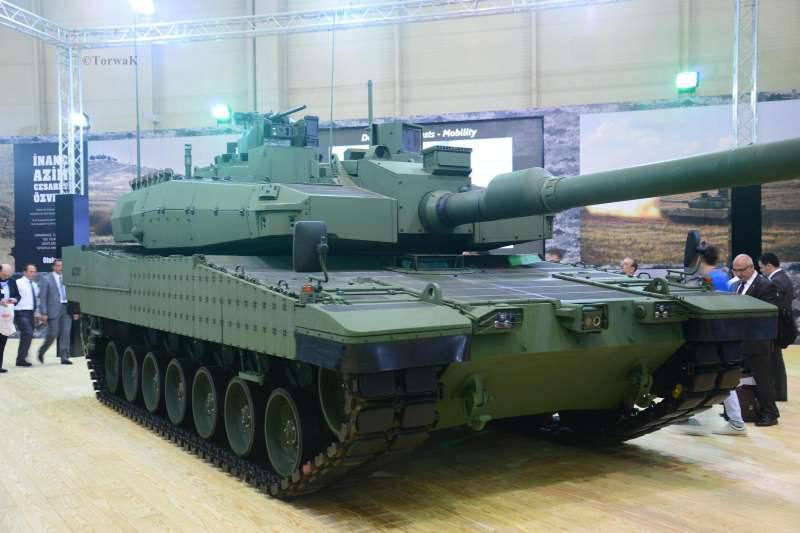
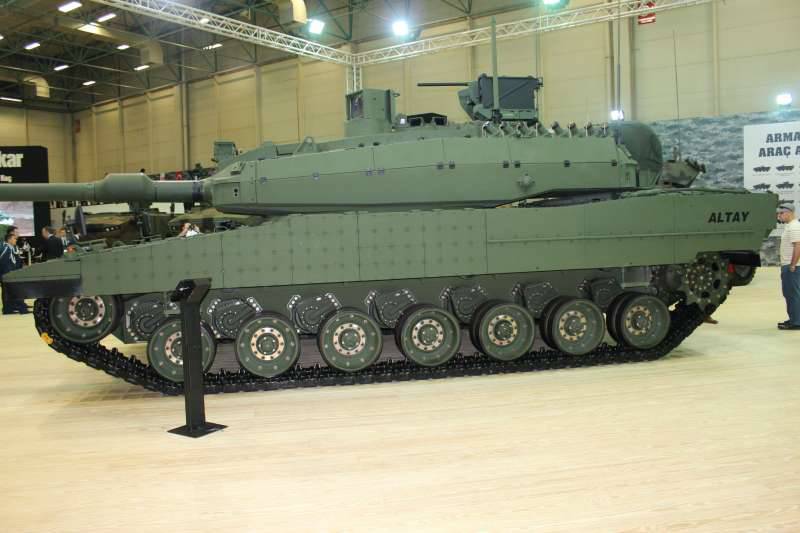
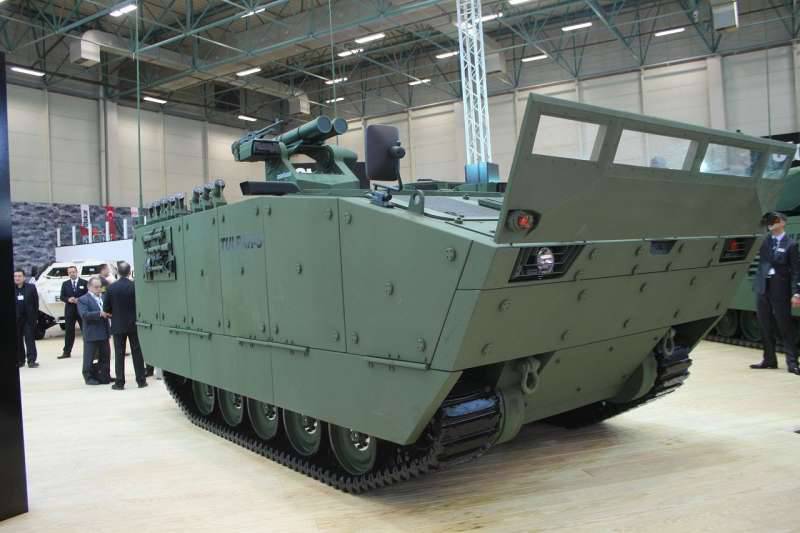
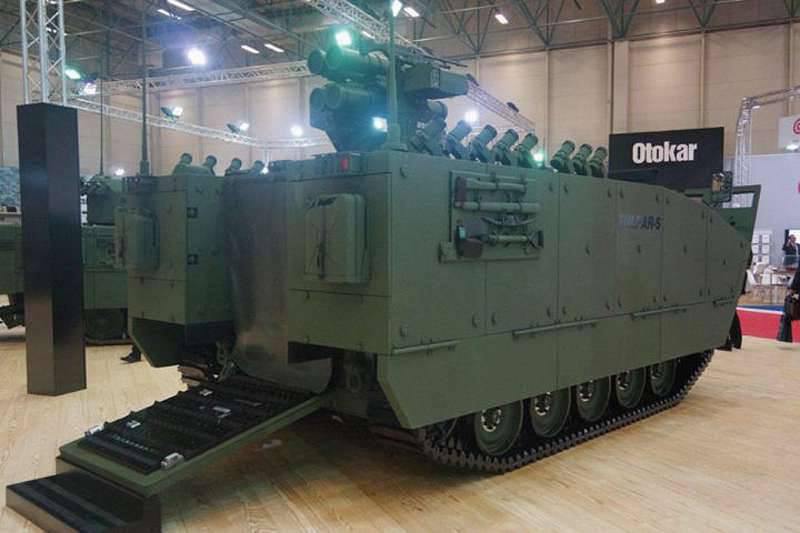
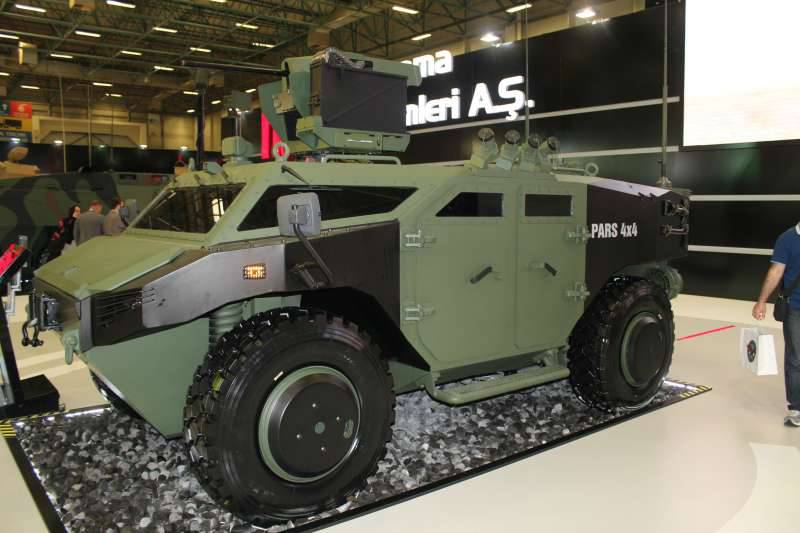
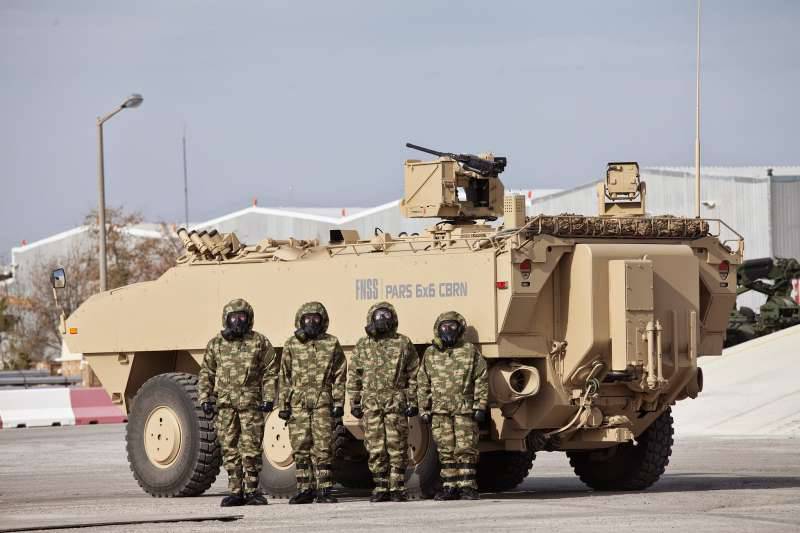
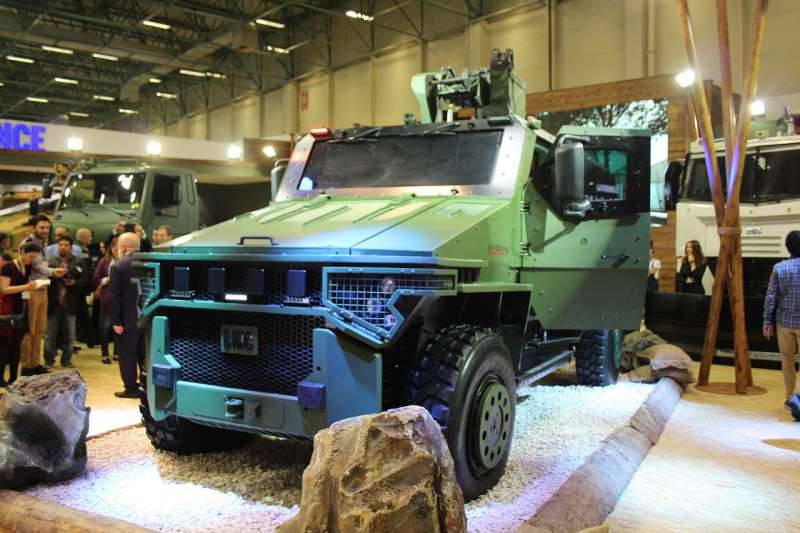
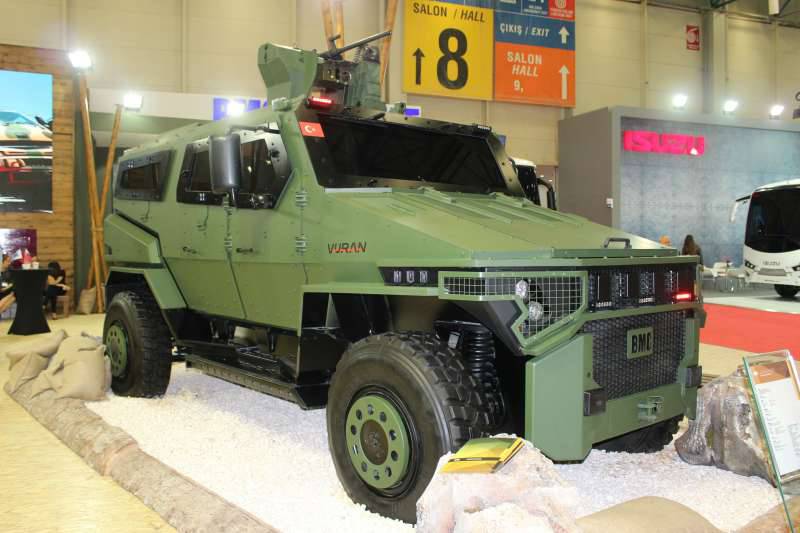
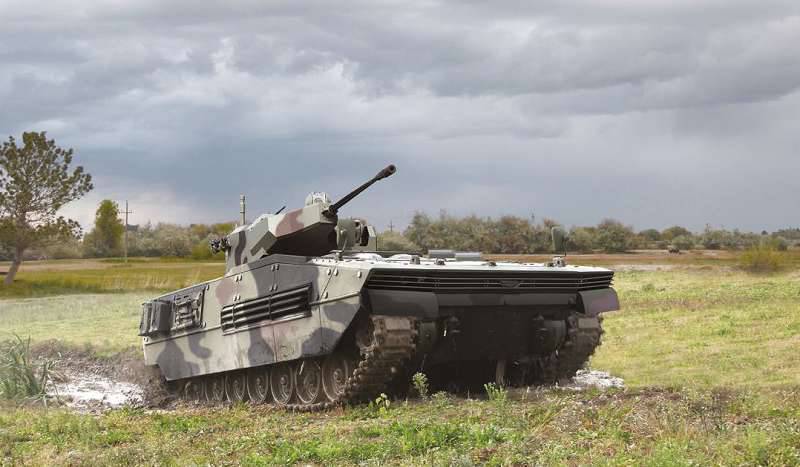
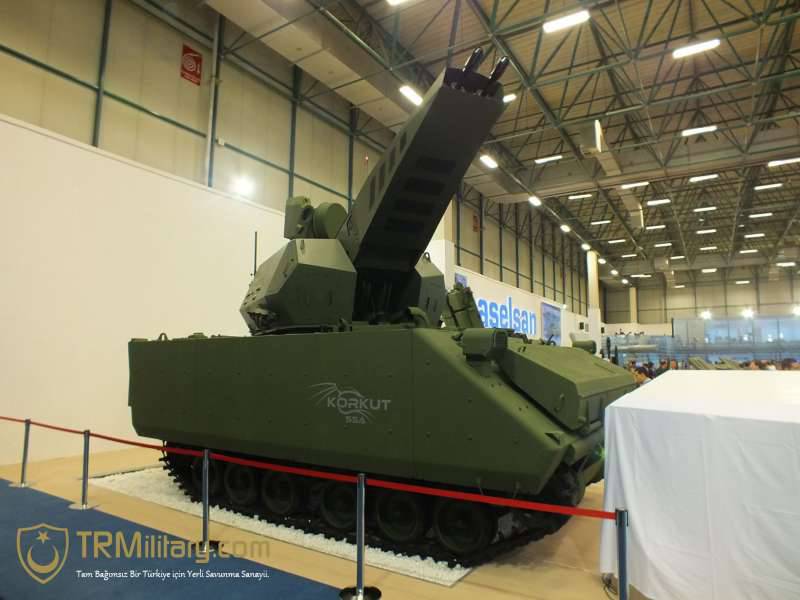
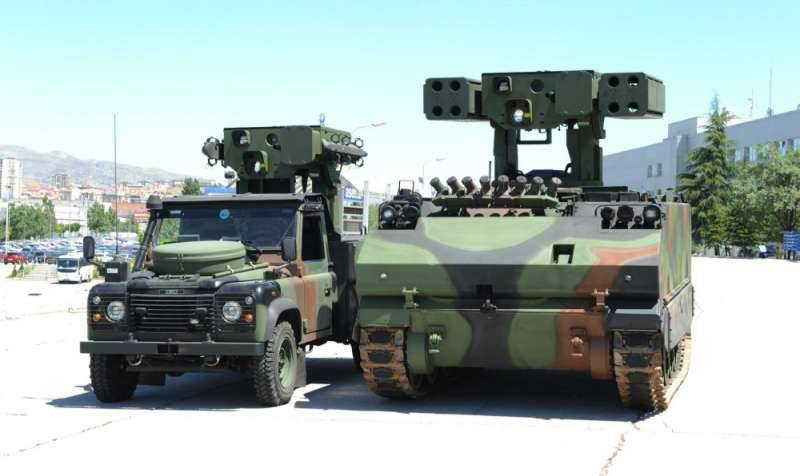
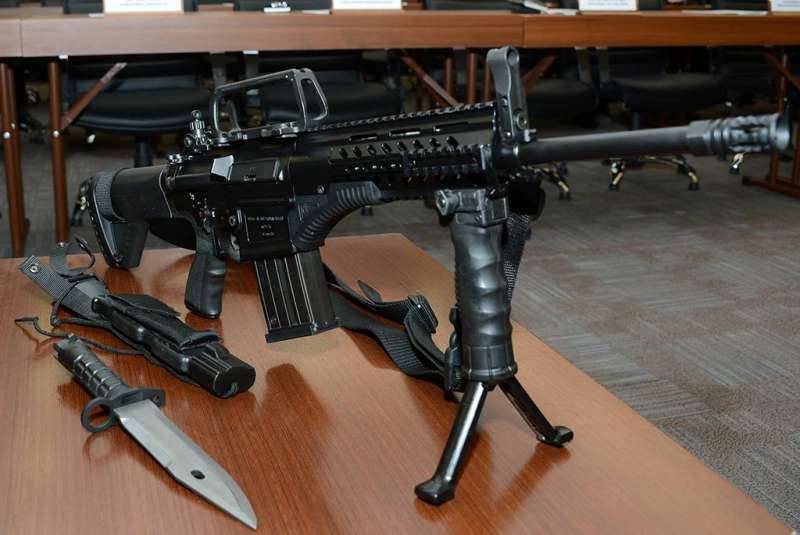
Information